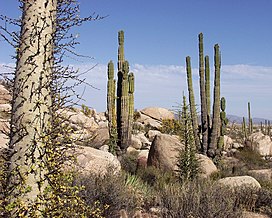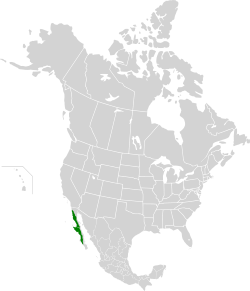
The Baja California Peninsula is a peninsula in Northwestern Mexico. It separates the Pacific Ocean from the Gulf of California. The peninsula extends 1,247 km from Mexicali, Baja California in the north to Cabo San Lucas, Baja California Sur in the south. It ranges from 40 km at its narrowest to 320 km at its widest point and has approximately 3,000 km of coastline and approximately 65 islands. The total area of the Baja California Peninsula is 143,390 km2 (55,360 sq mi), roughly the same area as the country of Nepal.

The Sonoran Desert is a North American desert and ecoregion that covers large parts of the southwestern United States, as well as Sonora in northwestern Mexico in, Baja California, and Baja California Sur. It is the hottest desert in Mexico. It has an area of 260,000 square kilometers (100,000 sq mi).

The Peninsular Ranges are a group of mountain ranges that stretch 1,500 km (930 mi) from Southern California to the southern tip of the Baja California Peninsula; they are part of the North American Coast Ranges, which run along the Pacific Coast from Alaska to Mexico. Elevations range from 500 to 10,834 feet.

The ecology of California can be understood by dividing the state into a number of ecoregions, which contain distinct ecological communities of plants and animals in a contiguous region. The ecoregions of California can be grouped into four major groups: desert ecoregions, Mediterranean ecoregions, forested mountains, and coastal forests.

The East Saharan montane xeric woodlands is an ecoregion of central Africa, a number of high mountains in the middle of the huge area of savanna on the edge of the Sahara Desert.

The Sierra de Juárez, also known as the Sierra Juarez, is a mountain range located in Tecate Municipality and northern Ensenada Municipality, within northern Baja California state of northwestern Mexico.

The Sierra Juárez and San Pedro Mártir pine–oak forests is a Nearctic temperate coniferous forests ecoregion that covers the higher elevations of the Sierra Juárez and Sierra San Pedro Mártir ranges of the Peninsular Ranges, of the northern Baja California Peninsula of Mexico. The pine–oak forests extend throughout the central portion of the Mexican state of Baja California and terminate near the border with the U.S. state of California.

The Sierra de la Laguna dry forests are a subtropical dry forest ecoregion of the southern Baja California Peninsula in Mexico.

The Sierra de la Giganta is a mountain range of eastern Baja California Sur state, located on the southern Baja California Peninsula in northwestern Mexico.

The Tamaulipan matorral is an ecoregion in the deserts and xeric shrublands biome on the eastern slopes of the Sierra Madre Oriental range in northeastern Mexico. It is a transitional ecoregion between the Tamaulipan mezquital and the Sierra Madre Oriental pine-oak forests to the west and the Veracruz moist forests to the south.

The Gulf of California xeric scrub is a xeric shrubland ecoregion of Mexico's Baja California Peninsula.

The San Lucan xeric scrub is a xeric shrubland ecoregion of the southernmost Baja California Peninsula, in Los Cabos Municipality and eastern La Paz Municipality of southern Baja California Sur state, Mexico.

The Balsas dry forests is a tropical dry broadleaf forest ecoregion located in western and central Mexico.

The Chilean Matorral (NT1201) is a terrestrial ecoregion of central Chile, located on the west coast of South America. It is in the Mediterranean forests, woodlands, and scrub biome, part of the Neotropical realm.

The California coastal sage and chaparral is a Mediterranean forests, woodlands, and scrub ecoregion located in southwestern California and northwestern Baja California (Mexico). It is part of the larger California chaparral and woodlands ecoregion.

The Sinaloan dry forests is a tropical dry broadleaf forest ecoregion in western Mexico. It is the northernmost ecoregion of the Neotropical realm.

The Southwestern Arabian foothills savanna, also known as the Southwestern Arabian Escarpment shrublands and woodlands, is a desert and xeric shrubland ecoregion of the southern Arabian Peninsula, covering portions of Saudi Arabia, Yemen, and Oman.

The Northwest Mexican Coast mangroves is a mangrove ecoregion of the southern Baja California Peninsula and coastal Sonora and northern Sinaloa states in northwestern Mexico. They are the northernmost mangroves on the Pacific Coast of North America and the region is transitional between tropical and temperate seas.
Southern California Coastal–Baja California is a freshwater ecoregion in Western North America. It covers portions of central and southern California and west of the Coast Ranges as well as most of Mexico's Baja California Peninsula, extending from the southern end of Monterey Bay to the southern tip of the Baja California Peninsula.




















